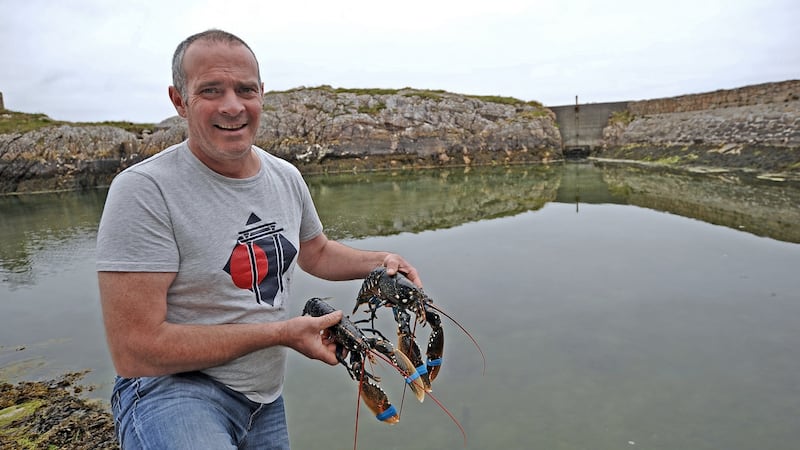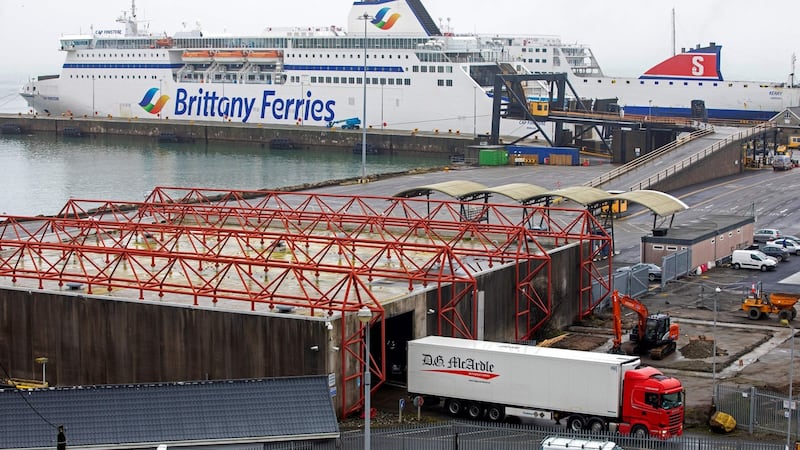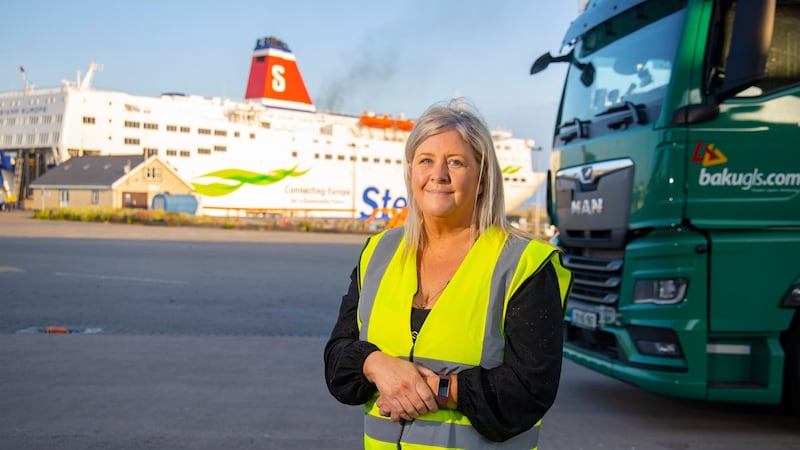Food exporter Cathal King has not sent a truckload of lobsters, crab and other live shellfish to customers in France or Spain through the UK since Brexit kicked in on January 1st.
The risk is just too great for a business like his, King's of Connemara in Cleggan, Co Galway. A lorry could be carrying up to €100,000 worth of produce in tanks of water.
"Since Brexit we haven't chanced it with the loads we are carrying. With a load of live shellfish it is a huge problem. Once you load the truck, the clock is ticking; you have to go. There is no room for error. There is a finite time for which it will live in the truck," says King.
But the direct ferries to mainland Europe – so popular since Brexit on January 1st – pose another problem: King needs to get his fresh produce to customers in France and Spain as soon as the shops open on Mondays but direct sailings only leave every other Sunday.
This is forcing King to look, reluctantly, at sending a truck across the British “landbridge” again. Before Brexit, this was the fastest and cheapest route to Europe with the least amount of hassle but, since Brexit, this is no longer guaranteed. Now, King is concerned about border checks at French ports on goods coming into mainland Europe from Britain.
“My only choice is to go through the UK but I am nervous. The value of the load is very high and it can go very wrong very quickly. If someone decided to keep me for a day I would be in real trouble. You just need to meet the wrong customs agent and you are in trouble,” he says.

Ro ro and lo lo
King is not alone. Many businesses have been bypassing Britain, at least immediately after Brexit, as traders did not want to risk their goods getting caught up in border checks.
Instead they turned to sending products via roll-on, roll-off (“ro-ro”) lorry freight or unaccompanied trailers or via lift-on, lift off (“lo-lo”) containers on the direct boats.
The Irish Maritime Development Office (IMDO) says that ro-ro traffic between the Republic and the EU roughly doubled in the first six months of this year and now represents one third of all ro-ro volumes for the Republic compared with a 17 per cent share in previous years. All ferry operators – Stena Line, Irish Ferries, CLdN and Brittany Ferries – have added capacity to the direct routes this year, while a new entrant, DFDS, began the new service between Rosslare and Dunkirk.
“The response of the shipping operators was just unprecedented in terms of the capacity they made available on direct services,” says Daniel Fallen Bailey, economic adviser to the IMDO.
Lo-lo traffic recorded its busiest ever quarter in the first three months of 2021 with the last quarter of last year being second busiest as businesses prepared for Brexit by shipping product ahead of the January 1st start-date for border checks and controls. The CLdN, operator of the mammoth "Brexit Buster" ships, is now making 10 calls a week into Dublin Port.
Dublin Port Company chief executive Eamonn O’Reilly described the growth in direct lo-lo container and dropped trailer freight traffic with continental Europe as “just extraordinary”.
“If you look out our fourth-floor window, you will see yards full of trailers that have come in or are going out to continental Europe. It is only when you see the physical volumes that you get a good picture of the fundamental change that has happened,” he says.
It has had a knock-on effect: the space taken up by the surge in dropped trailer business and the arrival of the Brexit Buster ships has meant Iarnród Éireann’s rail freight – just 0.7 per cent of freight coming through Dublin Port – has been temporarily stopped.
Where the direct ferry services gained, the Irish Sea services lost out, at least initially. Lorry traffic on boats between Ireland and Britain fell 20 per cent in the first six months compared with 2020 and a whopping 30 per cent compared to 2019, a better comparison as it predates Covid-19.
The six-month decline is more pronounced as lorry traffic fell 50 per cent in the early stages of 2021 as many businesses avoided initial post-Brexit border checks at Dublin Port in January and February. Many could do this because they had stockpiled before Brexit. Strict Covid-19 lockdown measures in early 2021 also suppressed ro-ro traffic volumes on all routes.

Stena Line, the biggest ferry operator on the Irish Sea, says that freight trade is 223 per cent ahead on its Rosslare-Cherbourg service but 37 per cent lower on its Dublin-Holyhead route.
But rumours of the death of the landbridge as a route to Europe for Irish businesses appear to be exaggerated. Irish Sea freight volumes are still much higher than the direct routes: some 180,000 lorries used direct ferries in the first half of this year; 354,000 used Irish Sea sailings.
Landbridge volumes
Like King’s seafood business in Connemara, many businesses are returning to the landbridge. This is down to the direct ferries being slower and 40 per cent more expensive, more frequent landbridge sailings, and growing confidence that businesses can manage Brexit border checks.
"The landbridge was never going to be defunct but it is highly unlikely that you will ever see the pre-Brexit landbridge volumes again. It is just how supply chains are adjusting," says Aidan Flynn, general manager of Freight Transport Association Ireland.
Ports and hauliers say that landbridge transiting returned slightly between April and June with the IMDO reporting a gradual recovery but that volumes are still well below 2019 levels.
"Only that there is not enough direct sailings, nobody would have gone back to the landbridge," says Ray Cole, transport director of Virginia International Logistics, which operates a fleet of about 120 trucks across Ireland, Britain and the rest of Europe.
“Companies have pushed to go back because we were charging them more for direct routes. Customers are starting to get their house in order with paperwork and getting the right procedures in place. In January and February there was a lot of hassle in France at their ports.”

Mary Mullins, a manager at Rosslare-based logistics company Baku GLS, said that it has customs processes in place to deal with the landbridge but companies are still slow to take risks.
“It is manageable but people are a little bit scared of going via Britain and dealing with customs and that their loads will be held up for days and days,” she says.
The shift to direct services has seen more lorries head for Rosslare in the past six months as the quickest direct way to Europe. The share of overall ro-ro traffic held by Rosslare Europort, the Iarnrod Éireann-run port, has risen from 10 to 16 per cent at the expense of Dublin Port.
General manager Glenn Carr said the port has seen a 400 per cent increase in direct freight as weekly direct sailings went from six last year to 28. He sees this growing further, not from "cannibalising" landbridge traffic, but from direct traffic to Europe from Dublin and Cork.
“People are managing the headache of the UK but it is still a headache and a cost. If that was to become more difficult, you would see more business move to direct routes but we have to ensure more capacity so we wouldn’t disappoint customers,” he says.
A “big unknown” will be the pressure from passenger demand when tourism returns in a post-Covid recovery, he adds.
Laurence O'Toole of Co Galway-based haulier O'Toole Transport, says his customers are pushing him to get back on the landbridge but he still sees problems, such as an office at the French port of Calais, where truckers must "close their transit" through England, which is not open 24/7.
Bureaucracy can still be nightmarish on the landbridge route – for example, one requirement to use a red pen on a health certificate delayed one of his shipment of fish being transported from Scotland to France. Another load was delayed for four days at Dublin Port because there was a request for the "catch certificate" on a load of tinned fish caught two years previously.
Looking ahead, he is concerned about the knock-on effect from October 1st when Britain starts its own border customs and regulatory checks on imports from the EU after a grace period ends.
“The landbridge, when it works, works well but the big unknown is when Britain turns on their checks,” he says.
“The import checks have prepared us for what’s coming but in the UK they consider themselves to be the gold standard in red tape so we haven’t much to look forward to.”
















